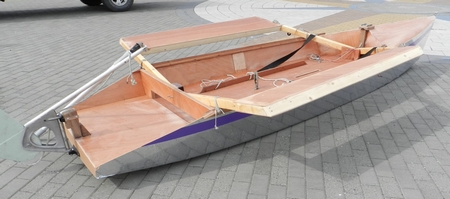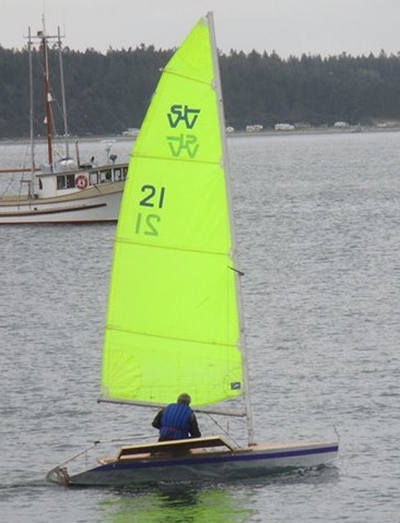Description
About Woods Downloadable Plans

Zest is a hiking (no trapeze) singlehanded racing dinghy and is based on my 50 years racing experience, which includes winning 2 singlehanded national championships (see my Biography page for more details).
This is the Zest we built in 2 days during the Edensaw Boatbuilding challenge . we started work on Friday morning. This was taken at 2pm Sunday after its first sail

Designed in the "classic" style, it has a simple hard chine stitch and glue plywood hull and features sitting out "wings", which are demountable and simply slot into sockets on the main bulkheads. The wings form a very comfortable angled "gunwale" to sit on, as there is no hard edge to dig into your thigh, and it's great to be sitting dry, high above the water.
I didn't want it to be too extreme, preferring a boat that you can race straight away, rather than one that comes with a steep learning curve. The ideal crew weight is between 70-90kgs, but lighter helms will need to be more athletic.
The wings are foam filled, and thus fully buoyant, which gives extra stability down to lee, where it matters, when the boat heels. They taper fore/aft to act as "skis" when they dig in. Zest's overall beam is moderate, as wings that are too wide make a boat tricky to sail and, especially, to tack. The wings also help prevent "death rolls" and windward capsizes.

Although the hull is a simple dory shape, there is a chine aft, which reduces transom drag in light winds. The cockpit floor is self draining, so there's no bailing and it's easy to right after a capsize. The open transom also makes it easier to get back on board over the stern. Most important, and unlike many other similar designs, there is plenty of built in buoyancy for safety.

Both foils have moderate aspect ratio. A higher AR may be more efficient, but is also thinner, so there are bigger loads on a weaker structure, and are thus hard to home build. A high AR foil also stalls easier which would make the boat trickier to sail.

The daggerboard is parallel sided, so that when it is raised the slot is still filled and there's no turbulence. Only the bottom section is tapered, in line with modern thinking, to reduce drag from tip vortices. The rudder has a gently curved leading edge because, despite one's best care, rudders regularly drag on the ground when moving onshore and a sharp corner would quickly wear.
It was tempting to draw an unstayed mast, because of their many advantages. However using an unstayed mast makes it tricky to make the sail set well, the mast and sail need to be tuned together - great for a single production builder, but difficult for home builders. Furthermore, the conventional round tube and sleeved sail (Laser style) means there is no halyard - most people want to lower just the sail, not have to take the whole rig down. So Zest has a simple stayed mast, which may quite possibly be a used one, eg from 420 or similar dinghy.
Zest features a centre mainsheet, as that makes gybing easier (always a tricky manouver on a fast singlehander) and sail controls are led to the wings on each side.
A fully battened sail is shown, but a half battened (just top two full length battens) is an option. At this stage I am not drawing an asymmetric spinnaker, as that is generally too challenging for most sailors.

Zest is lightweight and cheap to build, built using only 3 sheets of 4mm, 1 sheet 3mm and 1 sheet 6mm ply. "The concept was for a very simple build, indeed it should be possible to build the hull over a weekend (unpainted of course!)". I wrote those words early in 2015. In September 2105 we proved it by starting to build a Zest on a Friday and I sailed it on Sunday, see photo above. You can see more HERE
Finally, the Zest is light and narrow enough to cartop.

It isn't a boat just for "old men" like me. This photo shows some younger builders They are all middle school students at Dr. E. A. Ricci Middle School, North Providence, RI.
They built the boat in a 6 weeks summer camp. Really impressive work!
You can see a basic PDF studyplan HERE and some sample plan sheets HERE
Complete building plans are now finished and are available as a download zip file of PDFs. They cost GBP70 (USD95). To order plans please go HERE and put 70 in the Consultancy and Special Offers box. I will then email you the plans as a zip file of PDFs
Kit boats in both the UK and Australia will shortly be available, please email me for more details
Basic Material List
5 sheets 4mm okoume plywood, (or 4 sheets 4mm, 1 sheet 3mm)
1 sheet 6mm okoume plywood
1/2sheet 12mm ply for foils (or laminate from timber strips)
1in x1in 25m
11/2in x 1in 5m
2in x 2in 6m
2in x 1in 5m
3kgs epoxy
50m 50mm glass tape
1sqm 200g cloth
500 18mm (3/4in) no6 st.steel screws
300x500 x 50mm polyurethene foam (as used in house insulation)
wood flour and filler as required
For notes about materials, plywood etc see
which-plywood-and-timber-should-i-use
and
what-does-par-timber-mean






